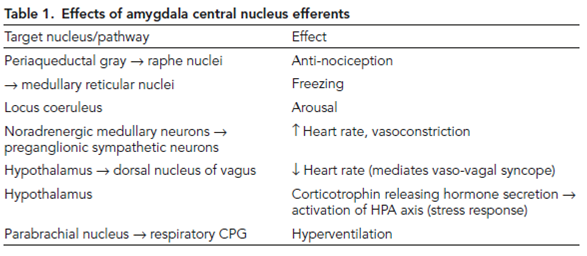Amygdala and fear learning
The amygdala is a group of nuclei in the white matter of the temporal lobe. Olfactory input runs from the olfactory bulb to the corticomedial nucleus. Sensory information from other modalities hearing, vision, somatosensory enters the basolateral nuclei from exacts thalamic nuclei and their corresponding fields of sensory cortex. The basolateral nuclei also get information about:
- The state of the viscera by the hypothalamus
- Arousal status from the nucleus basalis and locus coeruleus of Meynert
- Cognitive processing through the orbital prefrontal cortex
The output of the amygdala is from its central nucleus and follows two anatomical ways. By Efferents to the hypothalamus, septum and various brainstem nuclei go to the stria terminalis although the ventral amygdalofugal path conveys connections to the nucleus accumbens. The functions of these results in the expression of emotions are described in Table 1.

The amygdala is implicated in innate fear responses. It has access to species-specific hard-wired neural representations of scary things for instance crocodiles, snakes, raptors to drive automatic fear responses.
It is also essential for aversive learning. A Fear conditioning happens when a neutral stimulus CS, like as a tone is paired with a noxious stimulus US, like as a brief electric foot shock. After various tone–shock pairings the tone becomes a negative reinforcer and it elicits conditioned fear responses CR, involving autonomic, endocrine, and behavioral signs of fear. The role of the amygdala in fear learning is well documented:
- The connections of the amygdale Table 1 and Figure supports its role in aversive learning because it activates the cholinergic attentional system, the sympathetic nervous system, and the release of stress hormones.
- Firing of amygdala (central nucleus) neurons correlates with the development of the fear responses.
- Lesions of the amygdala arise acquisition of new conditioned fear responses or expression of preexisting ones while they do not affect autonomic responses to aversive stimuli for instance the defense reaction that are organized through the hypothalamus.
- During the surgery electrical stimulation of the amygdala in humans, evokes feelings of apprehension and fear.
- Brain scans show enlarged activity in the amygdala in humans shown fearful faces.
This response is impaired in people in whom the amygdala is calcified, even though they are still able to identify individual faces. Hence the neural system for emotional memory is distinct from that for explicit memory of faces.Armed with representations of both innate and learned fear-inducing stimuli to compare with the ongoing data stream the amygdala calculate the significance of (i.e., the threat posed by) the current condition and organizes the appropriate visceral and avoidance responses. Various characteristics of amygdala function are noteworthy:
- Through the amygdala the evaluation of a stimulus starts earlier than any conscious cognitive appraisal of the condition.
- Amygdala fear learning is implicit learning that means the fear responses cannot be consciously generated. The amygdala develops more rapidly during infancy than the hippocampus which is responsible for explicit memory. In the duration of this time fearful memories, may be acquired that cannot later be consciously accounted for. This could underlie exacts phobias.
- Long-term emotional memories are probably stored in the cerebral cortex rather than the amygdala: presentation of fear-evoking stimuli activates visual association cortex and orbital prefrontal cortex as well as the amygdala.
- At the cellular stage fear learning through the amygdala include NMDA receptor-dependent long-term potentiation same to that underlying hippocampal learning.